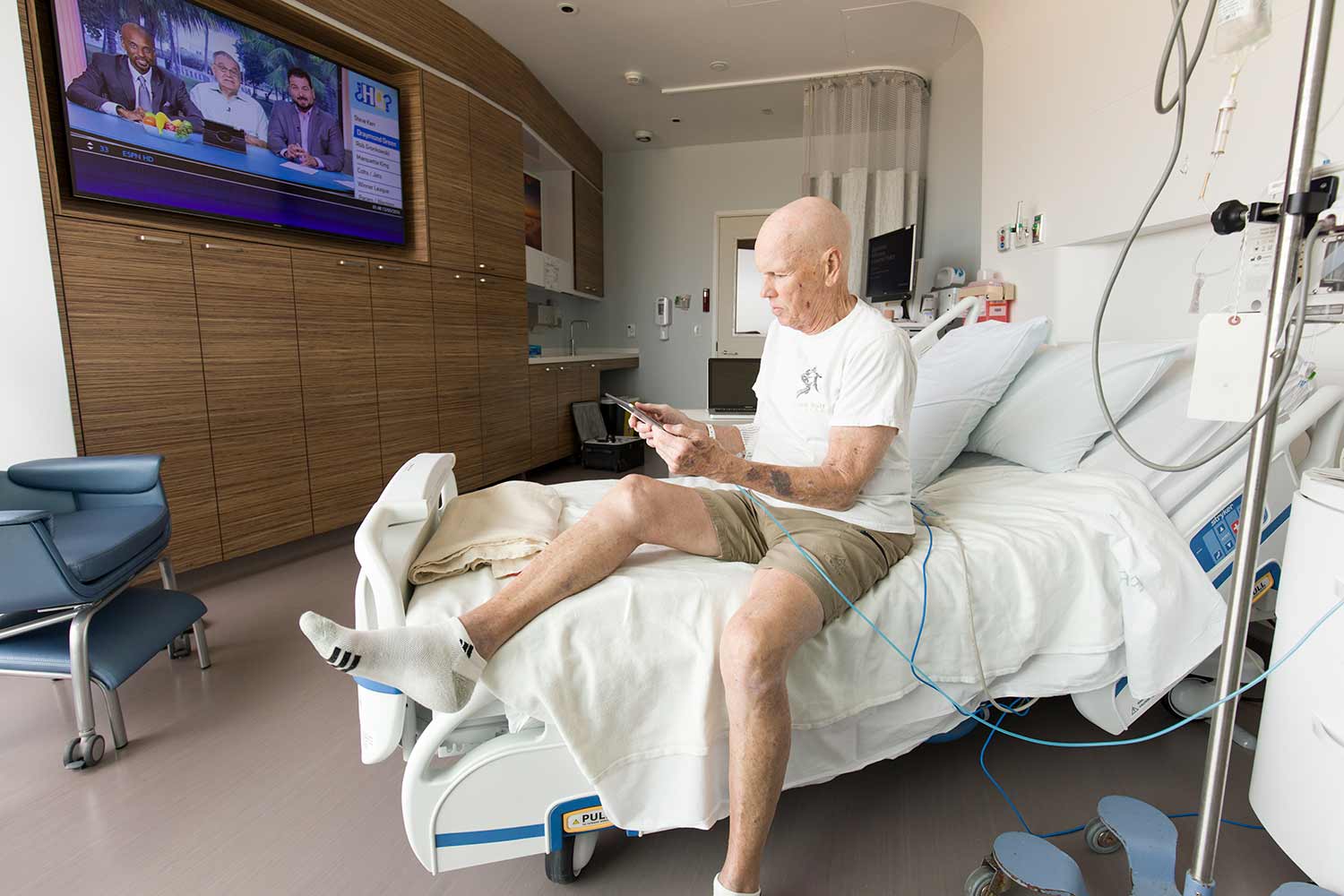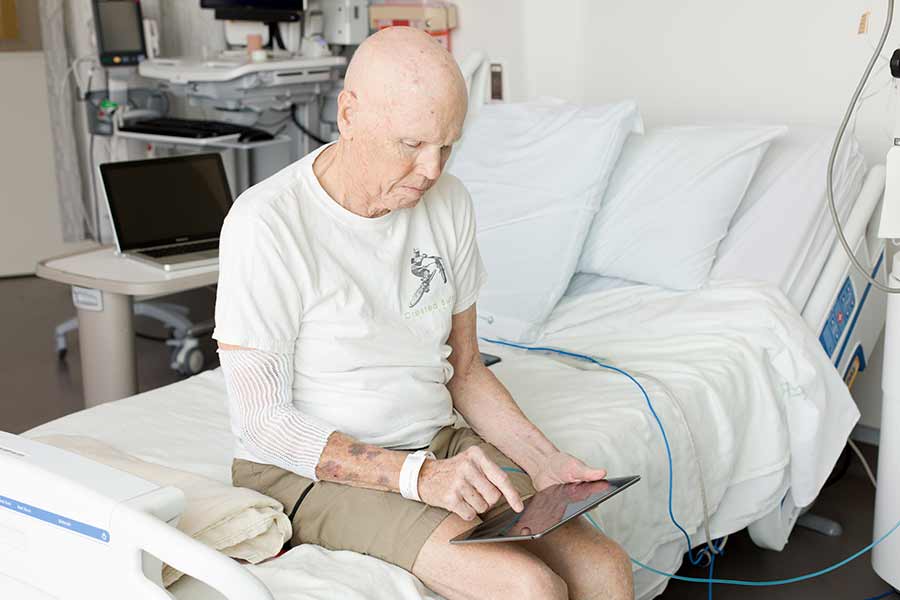By:
- Yadira Galindo
Published Date
By:
- Yadira Galindo
Share This:

Every patient room at the newly opened Jacobs Medical Center at UC San Diego Health is equipped with Apple TV and an iPad, allowing patients like Joseph Cussen to control their televisions, lights and other room features.
Lights, iPads, Action!
Technology Empowers Patients to Feel in Control at Newly Opened Jacobs Medical Center
Admiring a San Diego sunset through floor-to-ceiling windows, Joseph Cussen basks in the red glow reflecting off of a cascade of glass office buildings visible from across University Town Center. When the warm lights finally disappear, he picks up an Apple iPad that sits at his bedside. With a swipe and tap of the device, he adjusts the lights and the temperature and lowers the shades before settling in for the night.
“It’s the best views I’ve had in a long time,” said Cussen. “These windows are incredible. I watch the military jets fly over and enjoy the sunsets. I don’t feel trapped at all.”
Since the summer of 2016, Cussen has spent 70 days in hospitals while being treated for leukemia. In November, he became the first inpatient at the newly opened Jacobs Medical Center at UC San Diego Health. Besides the floor-to-ceiling windows in all patient rooms, the new medical center allows patients to employ a combination of technologies not found at other California hospitals, moving inpatient care to a new level.
“By adding connectivity in every patient room, each person can take control of their hospital experience through regulation of their environment to connecting online with friends and family for support,” said Dr. Thomas J. Savides, chief experience officer at UC San Diego Health. “Patients also see portions of their electronic medical record to help them understand their progress and anticipate daily events. We hope that feeling in control will aid in the healing process.”
Jacobs Medical Center, a 245-bed medical and surgical specialty hospital, has an iPad and Apple TV in every private room. Upon arrival to room, patients have immediate access to a tablet that allows them to take command of their room environment, reducing the need to call or wait for assistance to lower blinds or adjust the room temperature.
But it’s the secure access to their own medical records, using the new MyChart Bedside app, that enables patients to have more information in their hands than ever before. After patients create their own pin to access the tablet, and a second pin to access medical records, they have safe and easy access to test results, photographs and biographies of their healthcare team, a schedule of medications or upcoming procedures and educational materials prescribed by physicians.

Cussen finds access to his medical records through the MyChart Bedside app the most beneficial tool, giving him perspective on changes to his health.
“Some patients are very interested in lab results because discharge from the hospital depends on what the tests reveal,” said Marc Sylwestrzak, information services experience and development director at UC San Diego Health. “Patients find having this information readily available empowering. A combination of the security features, vital health data available through MyChart Bedside, control of the room environment and access to entertainment all available from an Apple iPad makes what we offer unique.”
As a patient in the blood and marrow transplantation program, Cussen wants to see lab results and other charts to see how his treatment is progressing.
“Having metrics ready to read every morning is terrific,” said Cussen. “I don’t have to wait for my nurse to visit my room. Before anyone comes in, I already have an idea of what awaits me for the day.”
When considering the latest technology available for an improved patient experience, the information services team’s first priority was patient privacy, said Sylwestrzak. Ensuring that a patient’s medical record and personal usage data is erased when the individual leaves the hospital room is critical.
To do this, the tablets leverage Jamf Pro (formerly Casper Suite) to automatically wipe patient data from each iPad immediately following a patient’s discharge and prepare the iPad for the next patient, leaving no trace of a previous user’s history. Jamf Pro communicates with Epic, the electronic health record system in place at UC San Diego Health, to coordinate iPad management with patient records, ensuring that patient privacy is protected at all times.
To manage the room environment, a Creston application is installed on each tablet for patients to adjust room temperature, lights and shades. iPads also are equipped with popular entertainment apps, but patients have the option to download their favorite apps as well. In addition, using the mirroring feature, patients can share what’s on the tablet with others in the room by pushing the content onto Apple TV.
“People come to us during their most vulnerable moments, when they need our expertise to treat their illness or injury,” said Savides. “When we designed Jacobs Medical Center at UC San Diego Health, we considered not just the physical needs of the patient but the whole person. By empowering patients with more information about their care and by giving them more control of their surroundings, we hope that patients feel that they are part of their healthcare team and feel at home with us.”
Cussen certainly does, calling his experience at Jacobs Medical Center amazing. Still, he’s looking forward to the day he can get back on his bike.
“My main goal right now is to stay in remission,” said Cussen. “Getting back to cycling would be a good metric. It would be the ultimate feeling.”
Share This:
You May Also Like
Stay in the Know
Keep up with all the latest from UC San Diego. Subscribe to the newsletter today.



